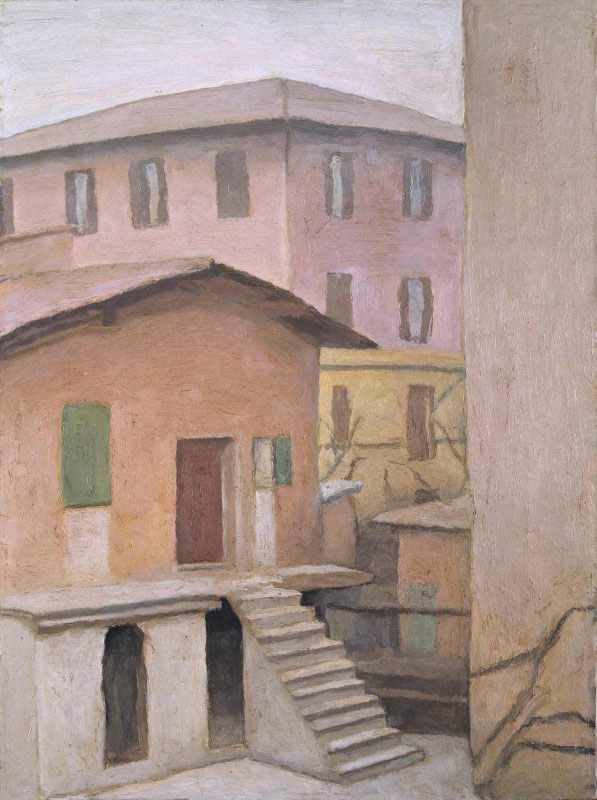配色-方大扎大道庭院Cortile di via Fondazza
简介:《方大扎大道庭院Cortile di via Fondazza》的配色图,配色百分比和色值,本作品是画家莫兰迪色系于1959 年创作的一幅风景油画绘画作品。

配色数据:颜色百分比+色值 (配色基于AI视觉算法生成,点此反馈)
色环分布:小圆圈可选、可移动 ( 常用色环配色法→ )
作品名称:Cortile di via Fondazza
中文名称:方大扎大道庭院
创作时间:1959 年
画作尺寸:40.5 x 45.5 cm
绘画类型:风景油画
流派:自成一派
题材:城市风光
原文介绍:
The starting point for Morandi’s complete œuvre is the everyday utilitarian object, household items such as dishes, jars, bottles, jugs, mugs and vases, which, by the use of elaborate arrangements, he places in ever new mutual associations. Starting from these real situations – which also include the view from the window – Morandi creates a basic repertoire of motifs which he uses in order to pursue, all the way to the borders of abstraction, his confrontation with painterly elements such as form, colour and volume.
In numerous different combinations, which he creates in a meticulous selection procedure and places against a monochrome, neutral background, he tirelessly plumbs the mutual relationships between things, painstakingly studying the effect of light and shade, as well as the interplay of contours, spatial co-ordinates and areas of colour in a variable compositional structure. The objects which Morandi carefully places, as if on a stage, are often re-arranged and exchanged. Intervals are re-assessed, proportions changed, light-and-dark effects created. In this mise-en-scène, minor shifts in the arrangement give rise to crucial transformations of the whole picture. The multifariousness of the resulting variations meant for Morandi that the ‘encounter of a coffee-pot with a vase on a table remained an unsolved and highly relevant problem right up to his death in 1964’ (C. Spies). In addition, Morandi explores the relationship between occupied space and the unoccupied space in between, allowing contours to stand out in contrast, so that even the empty spaces in the picture are given, so to speak, an outline and thus a concrete presence. As with the sort of puzzle picture where background becomes foreground and vice versa, the result is sometimes a confusing, not to say irritating, equivalence of positive, filled-in areas on the one hand, and negative, deliberately empty, areas on the other. The existential distinction between presence and absence is abolished. Released from their real-life context, the depicted objects often lose their spatial and temporal orientation, while their silent, statuesque presence comes across as archaic and timeless.
As a result, Morandi succeeded in bestowing a certain monumentality of the miniature status of his humble motifs, so that the jugs and vases, as stand-alone entities in space, take on the gravity of buildings. Although Morandi vigorously rejected any relationship with Pittura Metafisica, with which he grappled in 1918 and 1919, and saw his artistic endeavours more in the context of the Italian masters of the Trecento and Quattrocento, his compositional structures, in their painstaking balance between filled and unfilled pictorial zones, contain echoes of the staffage of Giorgio de Chirico’s stage-like, usually deserted public spaces.
Morandi does not strive for a faithful reproduction of a reality bound to real space, but is concerned, rather, with the artistic shaping of the pictorial space, with the exploration of painterly possibilities. ‘The only interest the visible world arouses in me,’ he once wrote, ‘concerns space, light, colour and forms.’ These fleeting phenomena create a changeable reality, which is hard to pin down. Morandi shared this concept of reality, which is not unchanging and constant, but can be experienced in the alternation of moods and impressions, with Paul Cézanne, who placed the individual gaze, the subjective artistic perception, and the artificiality of the aesthetic experience above the mere reproduction of reality. While the Cubists dissected forms into their individual facets and the Futurists sought the dynamic dissolution of form in dense sequences of movement units, Morandi devoted himself to form in its changing manifestation. He created concentrated impressions reduced to their essentials, ‘impressions’ of this inconstant reality, whose elements ultimately, in his late work, almost dissolve into abstraction.
机器翻译:
乔治·莫兰迪 (1890-1964) 很少离开家乡博洛尼亚,除了几次瑞士之行外从未出国旅行,他周围的环境始终是人们关注的焦点。观察者莫兰迪 (Morandi) 敏锐的眼光认识到平淡无奇的日常物品所固有的无穷无尽的多样性,而这些多样性可以通过仔细观察来体验。“一个人可以环游世界,什么也看不见。要了解一些东西,不需要看很多东西。人们只需要仔细检查它们。(莫兰迪)
莫兰迪全部作品的起点是日常实用物品,如盘子、罐子、瓶子、罐子、马克杯和花瓶等家居用品,他通过精心安排,将这些物品置于新的相互关联中。从这些真实情况开始——也包括窗外的景色——莫兰迪创造了一系列基本的主题,他用这些主题来追求,一直到抽象的边界,他与绘画元素如形式、颜色和体积。
在他精心挑选的众多不同组合中,他将这些组合置于单色、中性的背景下,孜孜不倦地探究事物之间的相互关系,潜心研究光影效果,以及轮廓、空间协调的相互作用-可变组成结构中的坐标和颜色区域。莫兰迪精心摆放的物品,就像在舞台上一样,经常被重新排列和交换。重新评估间隔,更改比例,创建明暗效果。在这种场面调度中,安排的微小变化会引起整个画面的关键转变。由此产生的变化的多样性对莫兰迪来说意味着“直到 1964 年他去世,咖啡壶和桌子上的花瓶的相遇仍然是一个未解决且高度相关的问题”(C. Spies)。此外,莫兰迪还探讨了被占用空间与未被占用空间之间的关系,让轮廓在对比中脱颖而出,以至于画面中的空白也可以说是有了轮廓,从而有了具体的存在。对于背景变成前景,反之亦然的拼图图片,结果有时令人困惑,更不用说恼人了,一方面是积极的,填充的区域,另一方面是消极的,故意留空的区域. 在场与不在场之间存在的区别被废除了。从他们的现实生活中释放出来,
结果,莫兰迪成功地为其不起眼的图案赋予了一定的纪念性,使水罐和花瓶作为空间中的独立实体,呈现出建筑物的重力。尽管莫兰迪极力拒绝与 Pittura Metafisica 有任何关系,他在 1918 年和 1919 年与之抗争,并且更多地在意大利 Trecento 和 Quattrocento 大师的背景下看到他的艺术努力,他的构图结构在填充和未填充之间进行了艰苦的平衡图片区,包含 Giorgio de Chirico 舞台般的工作人员的回声,通常是空无一人的公共空间。
莫兰迪并不力求忠实再现与真实空间相结合的现实,而是关注绘画空间的艺术塑造,探索绘画的可能性。“我对可见世界的唯一兴趣,”他曾经写道,“与空间、光线、颜色和形式有关。” 这些转瞬即逝的现象创造了一个多变的现实,很难确定。莫兰迪与保罗·塞尚分享了这种现实的概念,现实不是一成不变的,而是可以在情绪和印象的交替中体验到的,他将个人的凝视、主观的艺术感知和审美体验的人工性置于艺术之上。仅仅是现实的再现。立体主义者将形式分解成各个方面,而未来主义者则在密集的运动单元序列中寻求形式的动态分解,而莫兰迪则致力于形式不断变化的表现形式。他创造了浓缩的印象,简化为它们的本质,对这种变化无常的现实的“印象”,其元素最终在他后期的作品中几乎溶解为抽象。
原画TIF大图下载:
暂无大图
2、本资源部分来源其他平台或互联网收集,如有侵权请联系及时处理。







